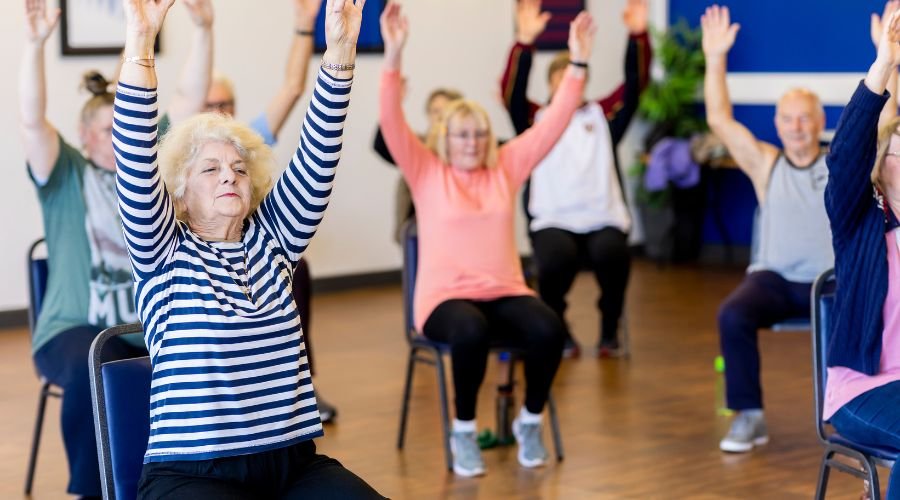Exercise is vital for maintaining physical health, improving mobility, and enhancing emotional well-being, especially for seniors or individuals with limited mobility. Caregivers play a crucial role in facilitating safe and effective exercise routines tailored to the needs of their care recipients.
Guidelines for Exercise Assistance
1. Preparation
- Communicate: Clearly explain the purpose and steps of each exercise. Use verbal instructions, visual cues, or gentle touch to ensure understanding and cooperation.
- Environment: Create a safe, clutter-free space with stable support like chairs or handrails. Ensure the client wears comfortable clothing and non-slip footwear.
- Warm-Up: Begin with light stretches to increase blood flow, improve flexibility, and prepare muscles for movement. Stretching also reduces the risk of injury.
2. Assisting with Exercises
- Active Assistance: Encourage the client to perform movements independently as much as possible. Provide guidance or support only when necessary to help them complete the activity.
- Passive Assistance: For clients with severe mobility limitations, gently move their limbs through the range of motion exercises while ensuring comfort and avoiding strain.
- Joint Support: Use flat palms to support joints during movements rather than fingertips to minimize discomfort.
Example Exercises
- Seated Knee-to-Chest: Assist in lifting one knee toward the chest while ensuring proper posture. This improves core strength and flexibility.
- Hamstring Stretch: Guide the client’s leg outward on a bed or chair to stretch the hamstring muscles gently.
- Upper-Limb Exercises: Help with arm raises or shoulder rotations to enhance mobility and strength in individuals recovering from conditions like stroke.
Safety Tips
- Monitor for signs of discomfort, fatigue, or dizziness during exercises. Stop immediately if pain or instability occurs.
- Gradually increase exercise intensity based on the client’s progress and comfort level.
- Always consult a healthcare provider before starting any new exercise routine.
By providing personalized support and encouragement, caregivers can make exercise a positive experience that promotes physical health, independence, and emotional well-being.
Guidelines for Range of Motion (ROM) Exercises
Range of Motion (ROM) exercises are essential for maintaining joint flexibility, preventing stiffness, and improving circulation. These exercises are particularly beneficial for individuals with limited mobility or those recovering from injuries or surgeries. Caregivers play a key role in ensuring these exercises are performed safely and effectively.
1. Types of ROM Exercises
- Active ROM: The care recipient performs the movements independently, using their strength to move the joints.
- Active-Assisted ROM: The caregiver provides partial support to assist the care recipient in completing movements they cannot perform fully on their own.
- Passive ROM: The caregiver moves the recipient’s joints entirely, without requiring any effort from the care recipient. This is ideal for individuals with severe mobility limitations.
2. Steps for Caregiver Assistance
- Positioning: Ensure the care recipient is seated or lying down in a comfortable and stable position. Proper positioning minimizes strain and provides a secure environment for movement.
- Support Joints: Use gentle but secure holds to support the joint being exercised. For example, during arm movements, support both the elbow and wrist to ensure stability and comfort.
- Movement Execution:
- Move each joint slowly through its natural range of motion until resistance is felt. Avoid forcing movements beyond this point.
- Stop immediately if the care recipient experiences pain beyond mild discomfort.
- Perform each motion 3–5 times per session, gradually increasing repetitions as tolerated.
- Monitor Progress: Observe any signs of discomfort, swelling, or reduced mobility during or after the session. Adjust the intensity or frequency of exercises based on these observations.

Example ROM Movements
- Shoulder Flexion/Extension: Gently lift the arm forward (flexion) and then lower it backwards (extension).
- Wrist Circles: Rotate the wrist slowly in both clockwise and counterclockwise directions to improve flexibility.
- Ankle Pumps: Move the foot up (dorsiflexion) and down (plantarflexion) to promote circulation and prevent stiffness in the ankles.
By incorporating ROM exercises into daily routines, caregivers can help clients maintain joint health, reduce stiffness, and improve overall mobility while ensuring safety and comfort throughout the process.
Caregiver’s Role at Each Step
Caregivers play a vital role in supporting care recipients during exercise routines, ensuring not only physical safety but also emotional well-being. Below is a breakdown of their responsibilities at each step.
1. Encouragement and Emotional Support
- Motivate Participation: Encourage the care recipient to engage actively in exercises, emphasizing the benefits of movement for their health and independence. Motivation fosters a positive attitude toward physical activity.
- Offer Positive Reinforcement: Provide verbal praise and reassurance to build confidence. Acknowledging small achievements can boost morale and encourage continued participation.
2. Physical Assistance
- Hands-On Support: Assist with mobility aids such as walkers, canes, or transfer belts to ensure stability during exercises. For clients with limited mobility, provide gentle hands-on guidance to help them complete movements safely.
- Controlled Movements: Use slow, steady motions to guide the care recipient through exercises, ensuring they are performed correctly without causing strain or discomfort.
3. Safety Monitoring
- Observe for Fatigue or Distress: Watch for signs of overexertion, such as heavy breathing, dizziness, or complaints of pain. Pause or modify exercises if necessary.
- Ensure Proper Alignment: Monitor the care recipient’s posture and joint alignment during movements to prevent injuries or unnecessary strain.
4. Collaboration with Professionals
- Follow Expert Guidance: Work closely with physical or occupational therapists to implement tailored exercise plans that address the care recipient’s specific needs and limitations.
- Monitor Progress: Regularly evaluate the care recipient’s progress in collaboration with therapists. Adjust exercise routines as needed to align with their evolving abilities and goals.
By encouraging, physical support, vigilant monitoring, and professional collaboration, caregivers can create a safe and empowering environment that promotes both physical health and emotional confidence during exercise routines.

